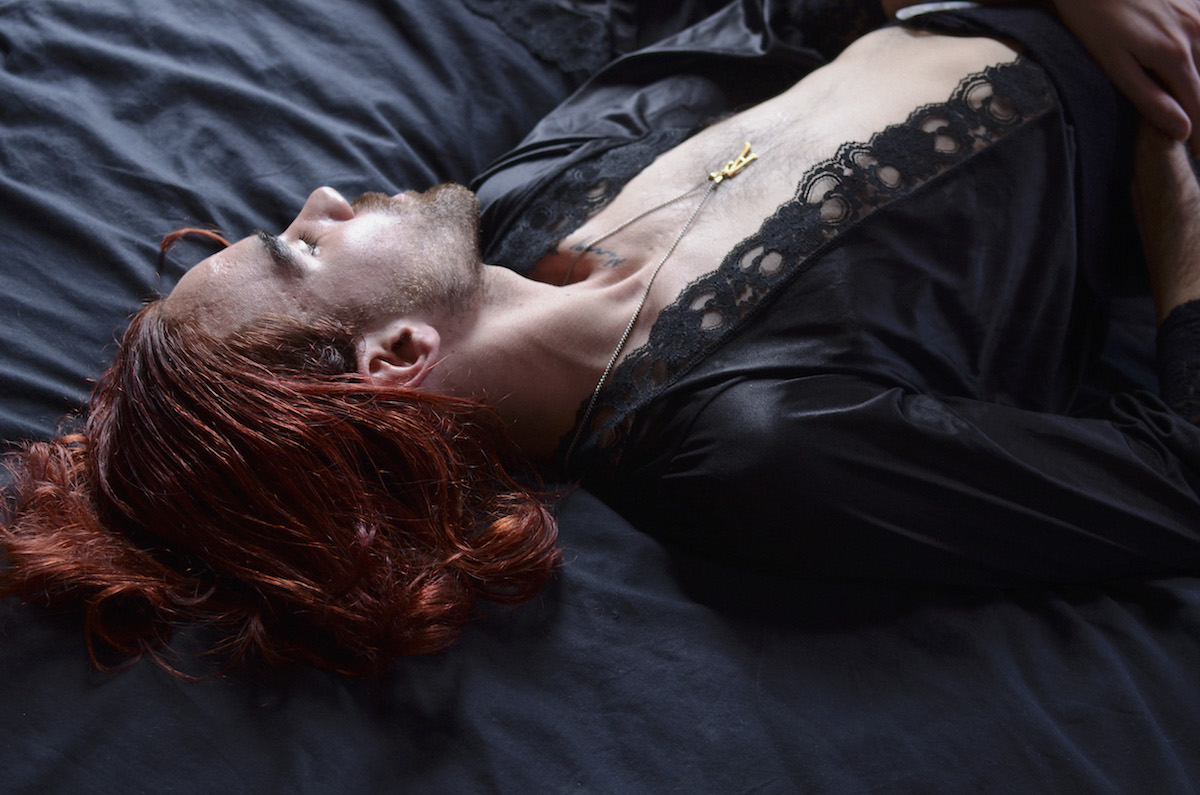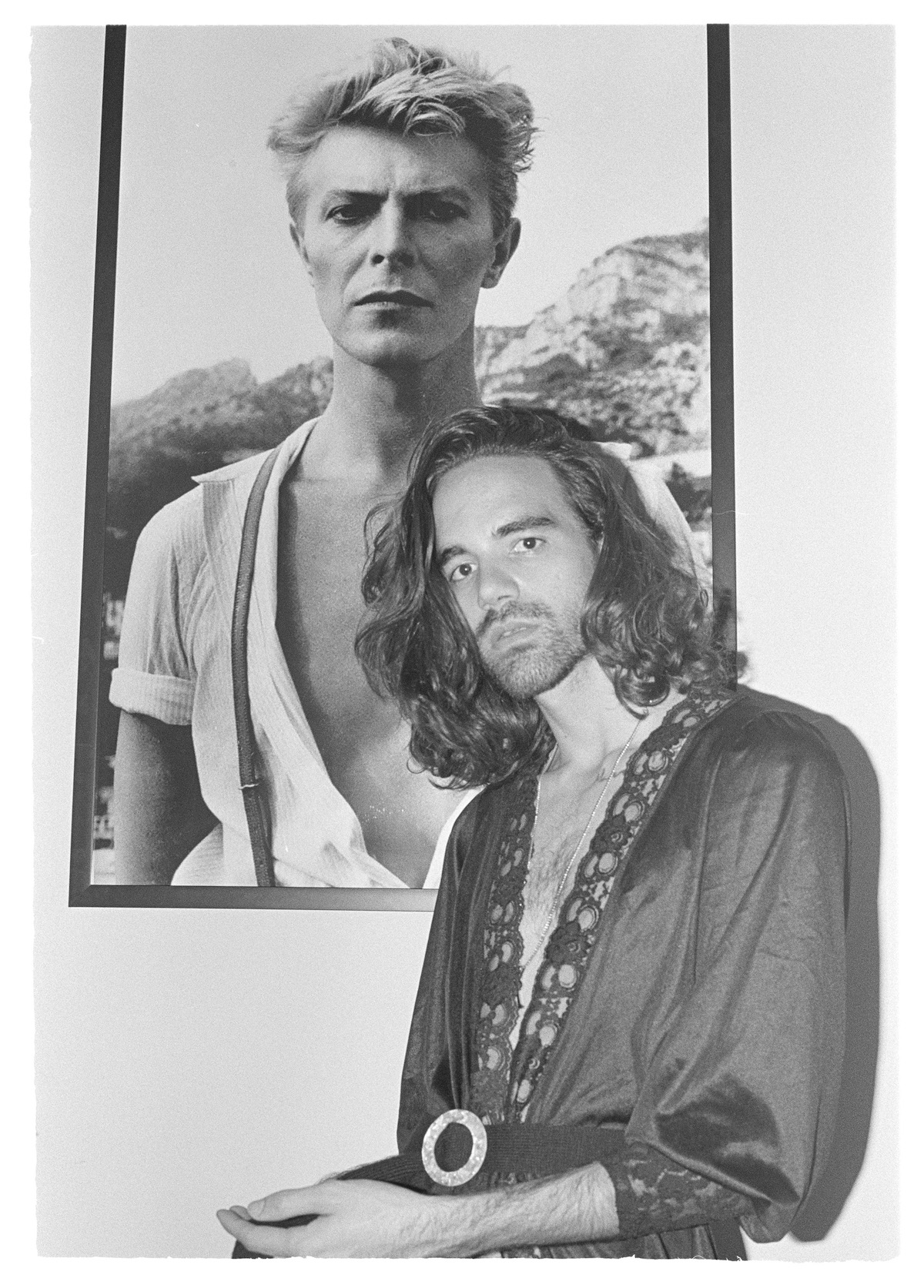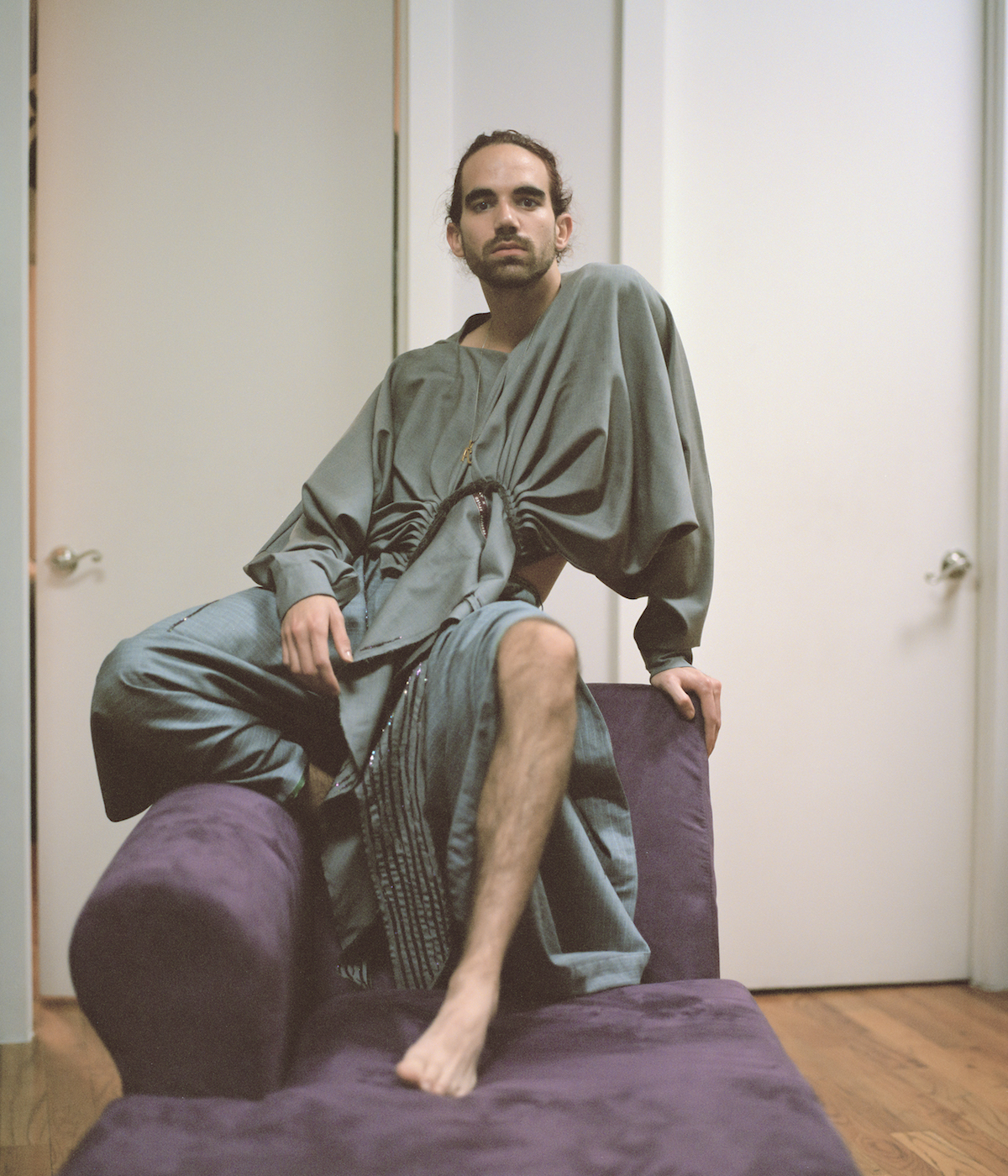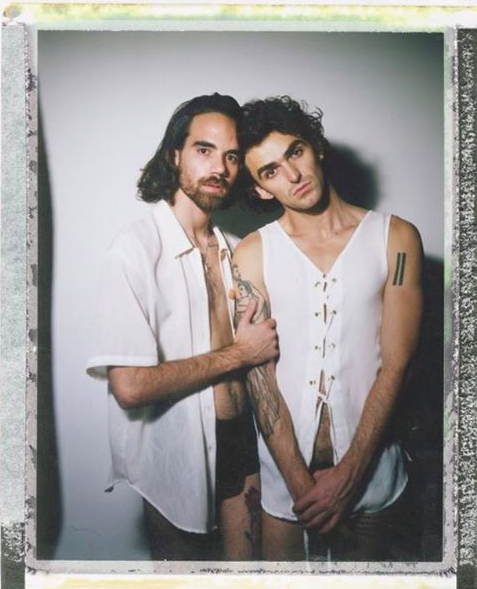Somebody Up There Likes Me: An Interview with Photographer Alexis Ruiseco
Culture — 29.05.17
Words: Patricia Ellah
Photography: Lili Peper, Patricia Ellah
Stylist: James Gallagher

Alexis opens his front door; his red shoulder length hair is tousled, he is wearing a black dressing gown and a long gold “A” chain resting right underneath his breastbone. Alexis Ruiseco Lombera is a Cuban-born artist from Miami and a friend of mine who also attended Parson the New School of Design for photography. His photographs explore self-portraiture, he recently went back to Cuba with the CubaOne Foundation and worked on a series of portraits exploring the queer community there. While we were at school, he was one of the students whose work and work ethic was respected by the professors we shared and most importantly our fellow peers. This attention is significant and an accomplishment in itself because art school is competitive and to gain respect from students that are also doing the same work and teachers who have taught the same revised syllabus for years, is not an easy feat. Every time I remind him of this admiration, Alexis always seems to be unaware of its existence which I find even more humbling.
He and I live quite close to each other in Brooklyn – something that we think is a sign of good faith from the universe. I walk for a few minutes until I reach the park turning left down his street to begin looking for a familiar grey stoop. I see a figure from afar who has to be the stylist James – who else would be carrying large black garment bags at this hour on such a gloomy day?
When we finally sit down to the interview Lili, one of the photographers and also a friend is also in conversation. Alexis has chosen Lana Del Rey’s albums Born to Die and Ultraviolence as the score for this interview.

Patricia: What things in your life keep you inspired? Let’s start with music, that’s always a good place to start.
Alexis: Since I got the email proposal, I’ve been thinking of albums or musicians that have given me perspective, and I keep coming back to the death of David Bowie. My roommate Joyce calls me drunk: “DAVID BOWIE PASSED AWAY!” The same day I had gotten my wisdom teeth removed so I couldn’t go drinking to celebrate the life and music of Bowie. I just remember feeling so strange that I was changed and affected by his death. He is someone that I have always been looking at regarding image and also music. When I was making my thesis work, I was listening to Young Americans. I would also talk to George about Bowie, and he suggested the film ‘The Last Five Years.’
George Pitts was a professor at Parsons who was Alexis’s thesis professor. He is a teacher that Alexis, Lili and I had in common. George taught a class called “Picturing Sexuality” that was always the first to fill up and a fight to get into. He passed away earlier this year in March, and the three of us went to his memorial together. His classes have been considered forward-thinking by every single one of his students. He was for many the John Keating (Robin Williams) to a vast Dead Poets Society. He was also a huge David Bowie fan.
I was so mesmerised by Bowie; how he lived his work 100%. When I got my hair dyed red, I was thinking of Bowie. I feel like when he is singing his songs, he is singing them to me. Sometimes I listen to Lana Del Rey’s music, and I feel like she is singing them about me – that I am the man she’s singing about in her songs.
Lili: Do you think this affects your self-portraiture?
Yes, even if it’s subtle, I am aware that I am trying to make these characters and these versions of myself. All the self-portraits are character studies but also an extension of myself. The reason I bring up Bowie a lot is that he also studied Judy Garland in the way that she acted, performed and used her voice. I study David Bowie, and it’s interesting that he’s learning from an actor. Theatre and cinema play a significant role in my work.

Entire Look Raiheth Rawla
In the Bowie film ‘The Last Five Years’ what stood out the most for you?
It was important to see Bowie go through so many different periods in his artistry and also to see him towards the end of the film talking about a terrible drug addiction – to a point where he felt he had to stop making music. It taught me that even though so many amazing things can be happening, you have to keep making work, you have to push through. I’ve felt that way, especially in 2013 when I was supposed to move to New York but couldn’t because of family, financials, etc. Sometimes being in a really low place can produce the best kind of work.
Who else is on the list of influences?
Let’s talk about Gaga. Something that attracted me to her was the way that she pushed for LGBTQ rights. But at the same time, she is my modern day Bowie, because as she progresses with her music, she manages to encompass different versions of herself. Watching Gaga, I sometimes wish that I could have seen Bowie in the same way – watching him as his career was flourishing. My favourite Lady Gaga albums are Born This Way and The Fame Monster. Those two albums and those two era’s were fucking incredible. There is also something about watching Gaga have all the access that she has, and it makes me wonder, ‘How do you create when you are in that place?’ I felt that Joanna was very white-washed, very Americana compared to her earlier days. Those early albums charged with so many different elements and had more urgency and less comfort. She had her Super Bowl performance, and it was incredible to see her go through her career and do that. But you are at the Super Bowl, you are Lady Gaga, Trump just won, where was my LGBTQ flag? She has spent her entire career riding on being this queer performer, with a queer community, and I understand that there all these politics in the industry or she might not want to make any political statements, but girllll pusssshhhhh throughhh!

“Verónica. Placetas, Cuba.” Courtesy of Alexis Ruiseco’s Instagram @letalexis.
Who did you look at when you were making your Cuba project?
The two people I looked at the most were Deana Lawson and Ana Mendieta. Deana Lawson is so groundbreaking. There is a picture that she has of this black man holding a shotgun, and he’s just leaning on the wall. There are the photographs of a man touching the stomach of his lover in a garden. I think the woman was pregnant, but how do you do that? How do you make a picture about motherhood – like black motherhood?
Tell me the role your mother plays in your work?
My mother is probably the most important person in my life, and she influences a lot of the work that I’ve made. Maybe the femininity in the ‘Reinas’ series was all inspired by her. (Reinas is Alexis thesis – a body of work made for his final year at Parsons.) Her attitude, the way that she likes to see herself photographed, the way she does her makeup and does her nails. My mother was incarcerated, and I was the only one in my family there for her. Our complex relationship is very much a foundation of the way I take things in and look at the world.
What are your favourite artist books?
Newspaper Magazine is a publication that I just recently got published in. It’s printed on newspaper, and the photographs are all black and white.
Alexis gets up to pull out his copy of the magazine then the oh’s, ah’s, and oh la la’s follow.
George pointed this photograph out to me (the image he has in Newspaper) and he said something, something that I don’t remember but I know that I’m taking what he said or that feeling to the grave. I don’t have a lot of photo books cause they’re so fucking expensive. But Helmut Newton’s Playboy work, Vivian Maier’s Self-portraits, and a Francesca Woodman book (from my ex-boyfriend.)
What are your favourite films or TV shows?
‘Exterminating Angels’, it’s considered controversial but a film that George showed us in Picturing Sexuality, but it left such an impression on me. ‘Moonlight’ was so important to me; I lived in the Spanish version of that kind of neighbourhood growing up. We don’t really see a black man depicted in a film like that, to be so emotional. There is a specific scene where the mother tells the son “no matter what, I’ll always love you.” That was so powerful and important to see in a film and also a moment that I’ve experienced as a queer person. I was always told, “boys don’t cry, men don’t show emotion, don’t you walk that way”. Maya Angelou talks about being abused and not talking for years about her childhood. I relate to that because I was so silent. I stayed in my room because I was probed for being different and I thought I was just doing me.

“Chris Ammon and me.” Courtesy of Alexis Ruiseco’s Instagram @letalexis.
Who is still living that you want to collaborate or work with?
Lady Gaga, Lana Del Rey, Harley Weir, and Kendrick Lamar. I had finished watching the video for “DNA”, and it was the first time in a while that I wished that I had been the one to make it. I would like to work with Tom Ford although he is quite elite. He also makes films; I just finished watching ‘Nocturnal Animals’ twice. It piqued my interest that he made that kind of film.
Lili: I think the film that was fascinating was ‘A Single Man.’ Especially since we are talking about his brand, which is very bourgeois. ‘A Single Man’ was accessible – a beautiful portrait of loss and emotion. Most specifically in that scene where Colin Firth gets the phone call that his lover is dead.
I haven’t seen it.
That scene gives me goosebumps. The book itself is by Christopher Isherwood; the whole book is an internal monologue. It’s a quiet film, but it’s just so fucking sad, I love sad things, and I can’t fucking help it. But it’s okay because I realise that sadness is a huge part of my life and how I identify with myself. And it’s important I say it because there’s nothing wrong with that.
Check out more from Alexis by viewing his website or following him on Instagram @letalexis.